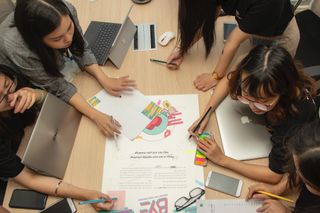Students engaged in high-quality active learning lessons learn more than those who learn from traditional lectures, research shows. But keeping students actively engaged in a productive manner is not always easy.
Here are some methods and strategies for adding more active learning to your teaching.
1. “Active” Doesn’t Automatically “Equal” Learning
“I despise the term ‘active learning,’” says Louis Deslauriers, who researches active learning and is director of Science Teaching and Learning in the Faculty of Arts and Sciences at Harvard University.
That’s because being actively engaged doesn’t simply equate to more efficient learning.
“If you read the textbook, if I were to do an MRI of your brain, we'd see that you're highly highly, highly engaged,” Deslauriers says. “If you're listening intently to a lecture, then in the strictest sense of the word, you are actively engaged.”
However, neither listening to a lecture or reading a textbook is the most efficient way to learn or what active learning is truly about. “What exactly do we mean by active learning?” Deslauriers says. “We mean that first, you have to be engaged. Obviously, that's number one. Number two, you have to be engaged productively. And number three, the productivity has to be toward a goal that is deemed worthwhile.”
Understanding this as an educator can help guide and prioritize your active learning strategies around what truly helps students.
2. Pause for the Active Learning Cause
Active learning, Deslauriers says, is all about prompting the right cognitive process in the minds of students. Sometimes you can do this simply by pausing during direct instruction and allowing students to think about questions related to the material being covered such as:
- Does this make sense to me?
- How is this relevant?
- Does it connect with something I already know? And if so, how do I integrate with what I already know?
- What sort of questions do I have right now?
- Can I repeat what the instructor just did? Or is it going to require a lot of practice?
“There's no way you can undergo these mental processes when someone keeps talking,” Deslauriers says. But if educators pause during their lectures and encourage this type of focus, they can help their students learn more efficiently.
3. Implement Peer Instruction Into Active Learning
Popularized in the 1990s by Harvard physics professor Eric Mazur, peer instruction involves asking students questions about key concepts during class and then providing immediate feedback while discussing their answers with peers and the instructor. Instructors can hand out electronic clickers, use web-based tools such as Google forms, or even go completely low-tech by giving color-coded cards to students that correspond to different answers. This helps students engage immediately with the material.
“The instructor shows the distribution of answers for the entire class,” Deslauriers says. “Students are getting feedback right away on what the correct answer is, and what their peers have answered.”
4. Use Evidence-Based Active Learning Technology
While active learning does not have to be high tech, there are many edtech tools designed to help with its implementation. For example, NoRILLA uses a real-world virtual interface to teach students about STEM. Designed for younger students, it features AI technology to offer personalized immediate feedback. The platform was developed by Dr. Nesra Yannier, a systems scientist at Human-Computer Interaction Institute at Carnegie Mellon University, with professors Ken Koedinger and Scott Hudson.
Yannier says that while developing NoRILLA, the team studied how much students learned from it versus traditional makerspace activities and interactive stations at museums. They found that the NoRILLA approach increased student learning. “We saw that if you do not have this AI interactive guidance, even though they were building a lot with materials, they did not learn the underlying principles, and they also could not transfer it to real-world building later,” Yannier says. “A lot of schools are trying to switch to active learning, but the way you use active learning is really important. It's not just doing any activity.”
5. Don’t Start with Project-Based Learning
Project-based learning is a type of active learning that many educators interested in active learning aspire to, but designing a full scale project-based class requires a great deal of resources and training. “If you’re trying to do project-based learning by yourself, you are almost certain to fail,” Deslauriers says. “But if you're trying to do peer instruction that I described earlier, then you have a decent chance.”
Deslauriers regularly visits classrooms in higher education and K-12, sometimes he finds ones in which students appear to be engaging in active learning. “I see everyone is working hard on worksheets,” he says. “They have a piece of paper in front of them, and they're talking with each other, and they're trying to fill the worksheet. But then when I look more closely, I can see that the worksheet is actually less than useless. It's a complete waste of time.”
On the opposite end of the spectrum, he’ll visit classes in which an educator is conducting what appears to be a traditional lecture. “And yet, the instructor stops talking every two minutes or so, and says, 'I want to give everyone time to think a little bit about what I just said. And, by the way, write down some questions you might have.' Then the instructor starts again. So on the surface of it, this looks like a traditional lecture, but there's quite a bit of active learning going on.”


